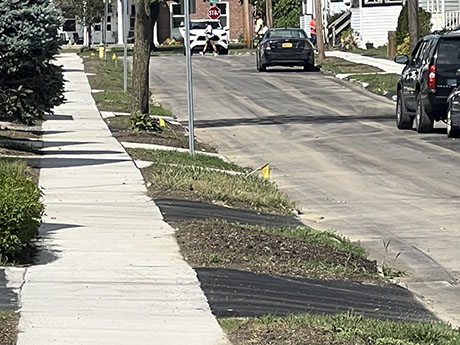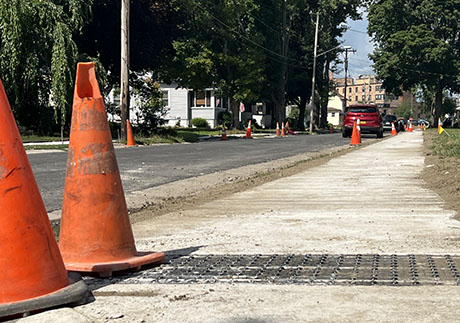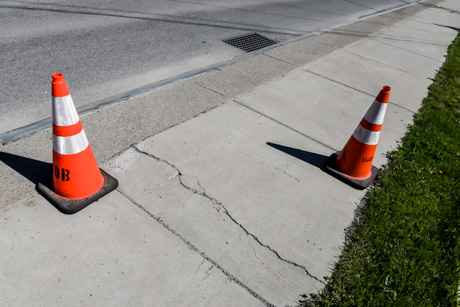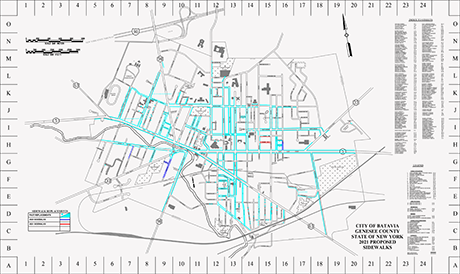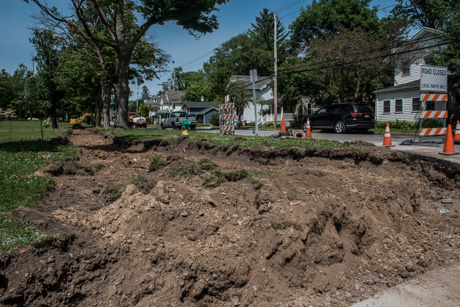The Batavian has been checking in with City Manager Rachael Tabelski quite a lot lately, not only to obtain updates about current and future projects but to inform Batavia’s residents about things that matter to them.
What always seems to be at the top of that list? Sidewalks. While there are brand new smooth and even walks on many streets, there are others that are more disheveled: upheaved at the corners, have cracks and other inconsistencies that can catch pedestrians by surprise at any moment. And if one section of the city is being repaired, folks wonder why their neighborhoods are being left out.
Councilwomen Kathy Briggs and Tammy Schmidt wondered the same thing during the council’s May meeting. They have been receiving complaints about sidewalks from their ward residents, said Briggs and Schmidt for the Fifth and Sixth wards, respectively.
Costly walkways ...
Those seemingly simple, square-shaped blocks of concrete — through online comments and at meetings — seem to cause much grief and anger. Yet, sidewalks are not simple. Nor cheap, Tabelski says.
“The cost of replacing a sidewalk and making it ADA compliant is twice as much as it is for the same length of the street, where we mill the street and fill it,” she said. So, for example, this year, we're going to be working on Columbia, Miller, and Seneca, right. And those streets will cost us roughly $80,000. To do the micro-surfacing on the street, and the sidewalks on those streets will cost us $300,000. So putting into comparison, the ability to pave streets, I think our DPW folks do a great job, trying to plan and continue to move street and sidewalk projects forward as fast as we possibly can with the resources we have.”
Making a sidewalk ADA —Americans with Disabilities Act-compliant takes a little extra work, with wider walkways for wheelchair access, rounded curbs and the studded metal plates that cap off each sidewalk going to a street.
“Yes, that’s one of the bigger parts of the cost; the ADA compliance,” she said. “And the concrete product that's used also is expensive as well. We do have professional staff members and engineers that work through capital plans and they are out monitoring the streets and sidewalks and they work through those plans and do the best they can with the budget they have to continue to move projects forward.”
A current pavement improvement project is at Miller, Columbia, and Seneca avenues. Part of this program includes pairing sidewalks with their adjacent streets so that an entire section is repaired at the same time, she said. It’s called the “Complete Streets” approach. The work will be funded with $320,000 from the state's Consolidated Highway Improvement Program.
“So whenever we are able to repave or resurface a roadway, we also look at the sidewalks to make sure they are now ADA compliant. They have appropriate widths for wheelchairs and passing lanes,” Tabelski said during the May meeting.
There is a capital street plan developed by city officials as they try to identify the streets that need immediate repair, and pairing sidewalks with them for work, she said.
This year the scope of work includes the replacement of approximately 6,400 linear feet of sidewalks and handicap-accessible ramps on portions of Chase Park, Fisher Park, and Seneca, Miller, and Columbia avenues.
Much of the city’s work is done behind the scenes, she said, away from the public eye and not always so obvious that anything is happening. But projects are “definitely something we spend a lot of time on in the city.” For a complete picture of work that has been, is in progress with being or yet to be done, refer to the city sidewalk map below.
A bright idea ...
Aside from huge capital projects and street/sidewalk improvements is a better light show, Tabelski said.
One by one, the city has a plan to replace the city’s traditional lightbulbs with brighter, more economical LED versions, she said during City Council’s recent meeting.
She presented a New York Power Authority LED Street Light Conversion Program. The nearly $1.7 million plan (Phase I) has an estimated savings of more than $161,000 annually.
City projects take time, planning, money, and labor, and — albeit piecemeal — they are coming to fruition, she said.
“We’re actually seeing the strategies that were put in place years and years ago, and people stuck to them and implemented them. Now it is coming to the execution stage with actual buildings going up. So I think that's kind of a neat thing to think about, for me, I was back at the IDA when these strategies were taking place. And I've been able to understand and believe in the strategy and be here to help move it forward,” she said. “So I think that's what I hope residents understand, that we really do have long-term plans to continue to bring offerings and growth into our city and make sure we keep up on our infrastructure. … and that the city's resilient for many years to come.”
Photo: File photo from 2020 by Howard Owens.
To view a higher resolution, PDF version of this illustration, click here.
